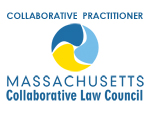The first step in facing divorce is to select the best divorce process for the two of you, for example, litigation or Collaboration (Collaborative Divorce).
Of course, you each have different interests and goals; in litigation, a judge may dismiss them outright; that will not happen in Collaborative Divorce.
The first step.
Usually, it is best for the two of you to decide on the process, before selecting your attorneys. Because attorneys are best at “what they do”, going to an attorney before selecting a process is not usually beneficial. For example, if you go to a surgery oncologist for advice on how to handle a newly discovered cancer, you will most likely get advice on the best surgery. If you go to a medical oncologist, you will get advice on cancer drugs. The radiology oncologist will give you advice on cancer radiation. It is the same in divorce. Study and select the process before selecting the attorney. Being good at divorce litigation does not qualify an attorney to be a Collaborative Divorce Attorney. Only Collaborative Divorce Certified Attorneys can provide Collaborative Divorce representation.
Divorce Litigation.
Litigation involves confrontation. Confrontation begins when one spouse declares, in a public document called a “Complaint for Divorce”, that he/she is suing the other for divorce and wants custody of the children (if any) and an equitable share of all property. In this public document, the Plaintiff is the accuser and the defendant is the accused or defender. (In litigation, proceedings and most documents will be open to and available to the public for viewing and copying.)
In litigation, there are rules, procedures and laws that set out the procedure for divorce litigation, for example, Time Standards.
When considering what process is best for a spouse’s needs and budget, it is important to understand the effect of Time Standards.
Time Standards establish a list of events that must be addressed. Failure to address an event could result in sanctions. Note, just because the Time Standards order certain events, for example, the completion, filing, and serving of a Financial Statement, litigators know there are other rules that permit parties to skip, delay or get around a Time Standards rule.
Sound confusing? For litigators it is not; for persons representing themselves, it may be the first of many revelations. If someone represents himself of herself, the goal is not to get it all right- that is not going to happen- the goal is to not pay a sanction when she or he gets it wrong.
For those considering cost issues, litigation, by its nature, will result in fees for attorneys to “address” required events. Given the number of “events” in the Time Standards, this can be costly.
In litigation, if you and your spouse cannot resolve your differences, you will have a court trial, where one judge will decide your “divorced” future.
Collaborative Divorce.
In Collaborative Divorce, spouses use the Court System once, when they appear for an uncontested divorce hearing of about five minutes. No Divorce Complaint! No Plaintiff! No Defendant! No Time Standards! No dirty linen washed in public!
Collaborative Divorce is a unique process where spouses and their own trained and certified Collaborative Attorneys and “coaches” work together for, and only for, resolution of all issues.
In Collaborative Divorce, the spouses, their respective lawyers and other Collaborative Team members make up the Collaborative Team. The Team has one goal, the collaborative resolution of all issues without trial or arbitration, or the threat of either.
The Collaborative Team includes coaches who make the process more efficient and usually less expensive. The most common Collaborative Coaches are the Facilitator and the Financial Neutral. Your Facilitator expedites the process by helping each spouse precisely identify short and long-term goals. Your Financial Neutral expedites the process by analyzing the unique needs of each family, identifying tax provisions related to those needs and creating realistic plans to preserve family income and property.
Each attorney will be a trained and certified Collaborative Divorce Attorney. (Not all attorneys are Collaboratively Certified.)
Collaborative Divorce is often the least expensive and most efficient approach because court appearances, filings and other litigation requirements are avoided and because Coaches, who often cost less than litigation attorneys do, perform services that litigation attorneys normally provide.
© 2015 by Attorney Anthony C. Adamopoulos


